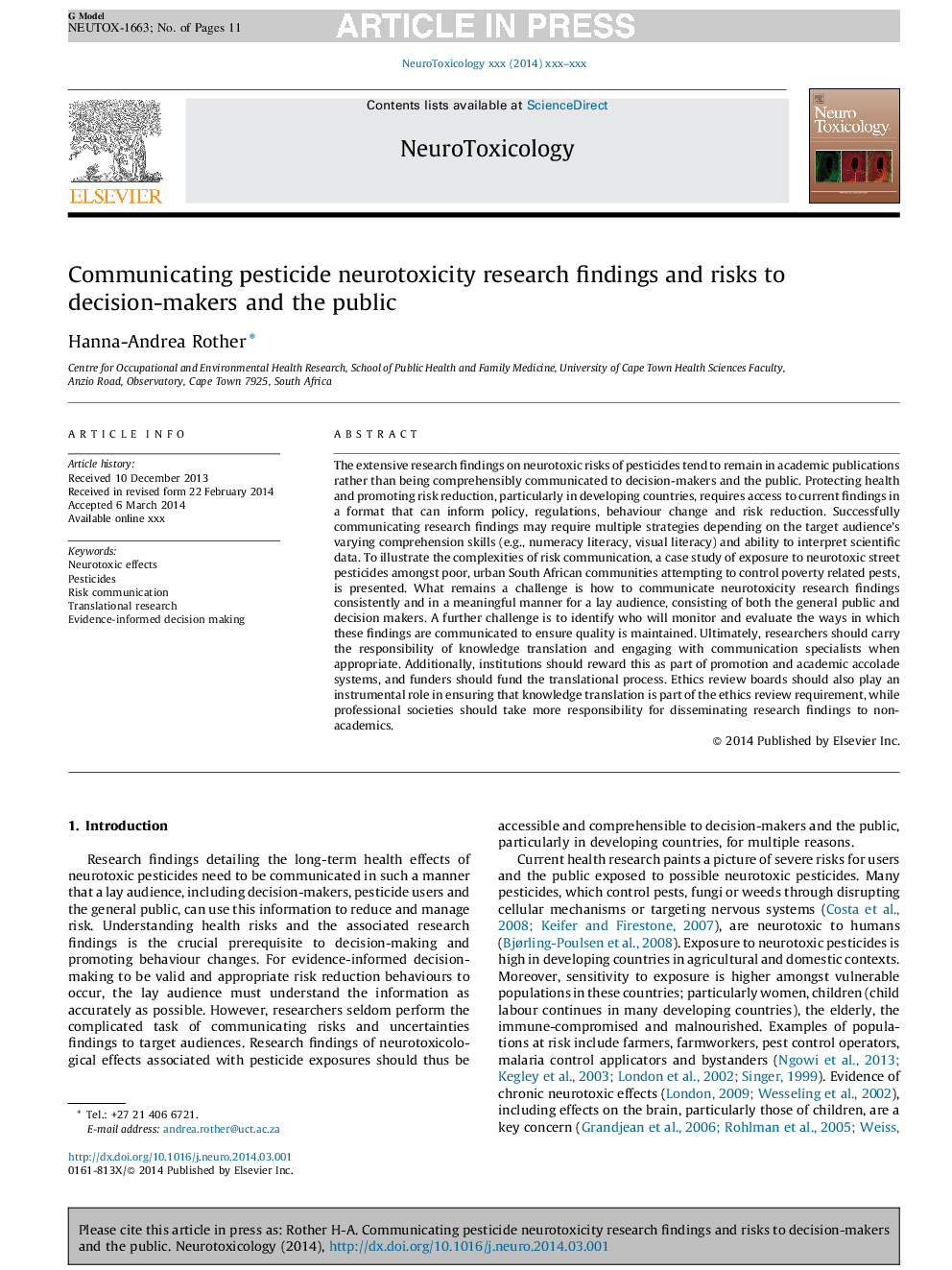| کد مقاله | کد نشریه | سال انتشار | مقاله انگلیسی | نسخه تمام متن |
|---|---|---|---|---|
| 5854949 | 1562049 | 2014 | 11 صفحه PDF | دانلود رایگان |
عنوان انگلیسی مقاله ISI
Communicating pesticide neurotoxicity research findings and risks to decision-makers and the public
ترجمه فارسی عنوان
اطلاع از یافته های پژوهشی تحقیقات عصبی آفت کش ها و خطرات آن برای تصمیم گیرندگان و مردم است
دانلود مقاله + سفارش ترجمه
دانلود مقاله ISI انگلیسی
رایگان برای ایرانیان
کلمات کلیدی
ترجمه چکیده
یافته های تحقیق گسترده ای در مورد خطرات آفت کش های عصبی به نظر می رسد در نشریات علمی باقی بماند و به طور قابل ملاحظه ای به تصمیم گیرندگان و مردم اطلاع ندهد. حفاظت از سلامتی و ترویج کاهش خطر، به ویژه در کشورهای در حال توسعه، نیازمند دسترسی به یافته های فعلی در یک قالب است که می تواند سیاست، مقررات، تغییر رفتار و کاهش خطر را در اختیار شما قرار دهد. ارتباط موفق با یافته های تحقیق ممکن است به چندین استراتژی بستگی دارد به مهارت های مختلف درک مخاطبان مخاطب (مثلا سواد حسابداری، سواد بصری) و توانایی تفسیر داده های علمی. برای نشان دادن پیچیدگی ارتباطات ریسک، مطالعه موردی قرار گرفتن در معرض آفت کش های خیابانی عصبی - روحی در میان جوامع فقیر و شهری آفریقای جنوبی که تلاش برای کنترل آفات فقر را دارند، ارائه شده است. یک چالش چالشی این است که چگونه ارتباطات تحقیقاتی عصبی را با هم برقرار کرده و به صورت معنی دار برای یک مخاطب نادیده بگیرد که متشکل از عموم مردم و تصمیم گیرندگان است. یک چالش دیگر این است که شناسایی کند که چه کسی این روش را بررسی و ارزیابی خواهد کرد که این یافته ها برای اطمینان از کیفیت حفظ می شود. در نهایت، محققان باید مسئولیت ترجمه دانش و مسئولیت ارتباط با متخصصان ارتباط را در صورت لزوم داشته باشند. علاوه بر این، موسسات باید به عنوان بخشی از نظام ارتقاء و ارتقای آکادمیک جایزه دهند و سرمایه گذاران باید روند ترجمه را تامین کنند. هیئت مدیره بررسی اخلاق نیز باید نقش مهمی در تضمین اینکه ترجمه دانش بخشی از الزامات بررسی اخلاق است، در حالی که جوامع حرفه ای باید مسئولیت انتشار یافته یافته های پژوهشی را برای غیر آکادمیک داشته باشند.
موضوعات مرتبط
علوم زیستی و بیوفناوری
علوم محیط زیست
بهداشت، سم شناسی و جهش زایی
چکیده انگلیسی
The extensive research findings on neurotoxic risks of pesticides tend to remain in academic publications rather than being comprehensibly communicated to decision-makers and the public. Protecting health and promoting risk reduction, particularly in developing countries, requires access to current findings in a format that can inform policy, regulations, behaviour change and risk reduction. Successfully communicating research findings may require multiple strategies depending on the target audience's varying comprehension skills (e.g., numeracy literacy, visual literacy) and ability to interpret scientific data. To illustrate the complexities of risk communication, a case study of exposure to neurotoxic street pesticides amongst poor, urban South African communities attempting to control poverty related pests, is presented. What remains a challenge is how to communicate neurotoxicity research findings consistently and in a meaningful manner for a lay audience, consisting of both the general public and decision makers. A further challenge is to identify who will monitor and evaluate the ways in which these findings are communicated to ensure quality is maintained. Ultimately, researchers should carry the responsibility of knowledge translation and engaging with communication specialists when appropriate. Additionally, institutions should reward this as part of promotion and academic accolade systems, and funders should fund the translational process. Ethics review boards should also play an instrumental role in ensuring that knowledge translation is part of the ethics review requirement, while professional societies should take more responsibility for disseminating research findings to non-academics.
ناشر
Database: Elsevier - ScienceDirect (ساینس دایرکت)
Journal: NeuroToxicology - Volume 45, December 2014, Pages 327-337
Journal: NeuroToxicology - Volume 45, December 2014, Pages 327-337
نویسندگان
Hanna-Andrea Rother,
